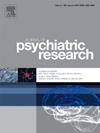Severity of autism-related symptoms in treatment-resistant schizophrenia: associations with cognitive performance, psychosocial functioning, and neurological soft signs — Clinical evidence and ROC analysis
IF 3.7
2区 医学
Q1 PSYCHIATRY
引用次数: 0
Abstract
Treatment-resistant schizophrenia (TRS) occurs when symptoms persist despite adequate antipsychotic treatment in terms of both timing and dosage. This severe condition is often overlooked, despite the existence of guidelines, with an average delay of 4–9 years before the introduction of clozapine, the gold standard treatment. We hypothesized that schizophrenia patients with severe autistic symptoms are more prone to develop TRS. To test this, we administered the Positive and Negative Syndrome Scale for Schizophrenia Autism Severity Scale (PAUSS) to 117 patients diagnosed with schizophrenia. Our results revealed that both TRS and clozapine non-responder (CLZ-nR) groups had higher rates of autistic symptoms than non-TRS patients. A machine learning model was developed to examine the relationship between PAUSS scores and TRS, obtaining an accuracy of 0.65 and an AUC of 0.67. Specifically, PAUSS items N6 (“lack of spontaneity and flow of conversation”) and N7 (“stereotypical thinking”) emerged as the most significant factors in the model. In addition, PAUSS was correlated with cognitive and social functions, as well as soft neurological signs, in TRS patients. Autism-related symptoms were found to predict significant variance in motor coordination, verbal fluency, functional ability and soft neurological signs. These results suggest that autism-related symptoms in schizophrenia may define a distinct subgroup with unique neurobiological characteristics.
难治性精神分裂症中自闭症相关症状的严重程度:与认知表现、社会心理功能和神经系统软症状的关联——临床证据和ROC分析
难治性精神分裂症(TRS)发生在尽管在时间和剂量方面进行了适当的抗精神病药物治疗,但症状仍然存在的情况下。尽管存在指南,但这种严重的情况往往被忽视,在引入氯氮平(金标准治疗)之前平均延迟4-9年。我们假设患有严重自闭症症状的精神分裂症患者更容易发生TRS。为了验证这一点,我们对117名被诊断为精神分裂症的患者进行了精神分裂症自闭症严重程度量表(PAUSS)的阳性和阴性综合征量表。我们的研究结果显示,TRS组和氯氮平无反应(CLZ-nR)组比非TRS组有更高的自闭症症状发生率。我们开发了一个机器学习模型来检验PAUSS分数和TRS之间的关系,得到了0.65的准确率和0.67的AUC。具体来说,PAUSS项目N6(“对话缺乏自发性和流畅性”)和N7(“刻板思维”)成为模型中最重要的因素。此外,在TRS患者中,PAUSS与认知和社会功能以及神经软体征相关。自闭症相关症状预测运动协调性、语言流畅性、功能能力和软神经症状的显著差异。这些结果表明,精神分裂症中的自闭症相关症状可能定义了一个具有独特神经生物学特征的独特亚群。
本文章由计算机程序翻译,如有差异,请以英文原文为准。
求助全文
约1分钟内获得全文
求助全文
来源期刊

Journal of psychiatric research
医学-精神病学
CiteScore
7.30
自引率
2.10%
发文量
622
审稿时长
130 days
期刊介绍:
Founded in 1961 to report on the latest work in psychiatry and cognate disciplines, the Journal of Psychiatric Research is dedicated to innovative and timely studies of four important areas of research:
(1) clinical studies of all disciplines relating to psychiatric illness, as well as normal human behaviour, including biochemical, physiological, genetic, environmental, social, psychological and epidemiological factors;
(2) basic studies pertaining to psychiatry in such fields as neuropsychopharmacology, neuroendocrinology, electrophysiology, genetics, experimental psychology and epidemiology;
(3) the growing application of clinical laboratory techniques in psychiatry, including imagery and spectroscopy of the brain, molecular biology and computer sciences;
 求助内容:
求助内容: 应助结果提醒方式:
应助结果提醒方式:


